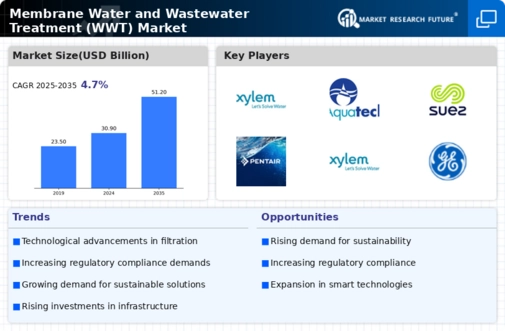Increasing Water Scarcity
The escalating issue of water scarcity is a primary driver for the Membrane Water and Wastewater Treatment Market (WWT) Market. As populations grow and industrial demands rise, the availability of clean water diminishes. This scarcity compels municipalities and industries to seek advanced treatment solutions, such as membrane technologies, to recycle and reuse water. According to recent data, the demand for treated wastewater is projected to increase significantly, with estimates suggesting that by 2030, the global water demand could exceed supply by 40%. Consequently, the Membrane Water and Wastewater Treatment Market (WWT) Market is likely to experience robust growth as stakeholders invest in innovative solutions to address this pressing challenge.
Rising Industrialization and Urbanization
The rapid pace of industrialization and urbanization is a crucial driver for the Membrane Water and Wastewater Treatment Market (WWT) Market. As urban populations expand and industries proliferate, the demand for efficient wastewater treatment solutions intensifies. Urban areas are particularly challenged by the need to manage increased wastewater volumes while ensuring compliance with environmental regulations. Membrane technologies offer effective solutions for treating industrial effluents and municipal wastewater, thereby supporting sustainable urban development. Data suggests that the industrial sector is one of the largest consumers of water, and as such, the Membrane Water and Wastewater Treatment Market (WWT) Market is likely to benefit from the ongoing trends in industrial growth and urban expansion.
Growing Awareness of Water Reuse and Recycling
The increasing awareness of water reuse and recycling is a significant driver for the Membrane Water and Wastewater Treatment Market (WWT) Market. As communities and industries recognize the value of treated wastewater as a resource, the demand for effective treatment solutions is surging. This trend is particularly evident in arid regions where water scarcity is acute. The implementation of water reuse programs is becoming more common, with many municipalities investing in membrane technologies to facilitate this process. Reports indicate that the global market for water reuse is expected to reach substantial figures in the coming years, further propelling the growth of the Membrane Water and Wastewater Treatment Market (WWT) Market.
Regulatory Pressures and Environmental Standards
Stringent regulations and environmental standards are increasingly shaping the landscape of the Membrane Water and Wastewater Treatment Market (WWT) Market. Governments worldwide are implementing stricter guidelines to ensure the protection of water resources and public health. These regulations often mandate the use of advanced treatment technologies, including membrane filtration, to meet effluent quality standards. For instance, the introduction of the European Union's Water Framework Directive has led to enhanced treatment requirements for wastewater. As a result, industries are compelled to adopt membrane technologies to comply with these regulations, thereby driving growth in the Membrane Water and Wastewater Treatment Market (WWT) Market.
Technological Advancements in Membrane Technologies
Technological advancements in membrane technologies are significantly influencing the Membrane Water and Wastewater Treatment Market (WWT) Market. Innovations such as improved membrane materials, enhanced filtration processes, and the integration of smart technologies are enhancing the efficiency and effectiveness of water treatment systems. For example, the development of nanofiltration and reverse osmosis membranes has led to higher permeate quality and lower energy consumption. These advancements not only improve operational efficiency but also reduce overall treatment costs, making membrane technologies more attractive to end-users. As a result, the Membrane Water and Wastewater Treatment Market (WWT) Market is poised for growth as these technologies become more widely adopted.


















Leave a Comment